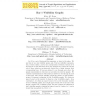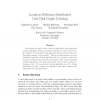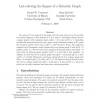284 search results - page 29 / 57 » On the adaptable chromatic number of graphs |
COMBINATORICA
2008
13 years 7 months ago
2008
A random geometric graph Gn is constructed by taking vertices X1, . . . , Xn Rd at random (i.i.d. according to some probability distribution with a bounded density function) and...
JGAA
2007
13 years 7 months ago
2007
Let S be a set of horizontal line segments, or bars, in the plane. We say that G is a bar visibility graph, and S its bar visibility representation, if there exists a one-to-one c...
SIROCCO
2007
13 years 8 months ago
2007
We present the first location oblivious distributed unit disk graph coloring algorithm having a provable performance ratio of three (i.e. the number of colors used by the algorit...
IPL
2000
13 years 7 months ago
2000
In this paper we study the performance of a particular on-line coloring algorithm, the First-Fit or Greedy algorithm, on a class of perfect graphs namely the permutation graphs. W...
JGT
2008
13 years 7 months ago
2008
The square G2 of a graph G is the graph with the same vertex set as G and with two vertices adjacent if their distance in G is at most 2. Thomassen showed that for a planar graph ...



